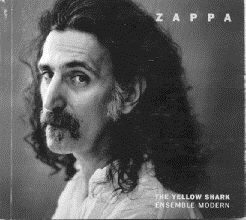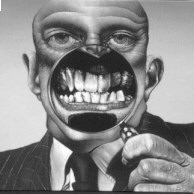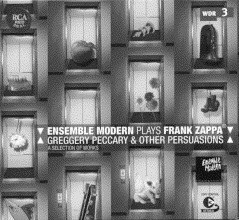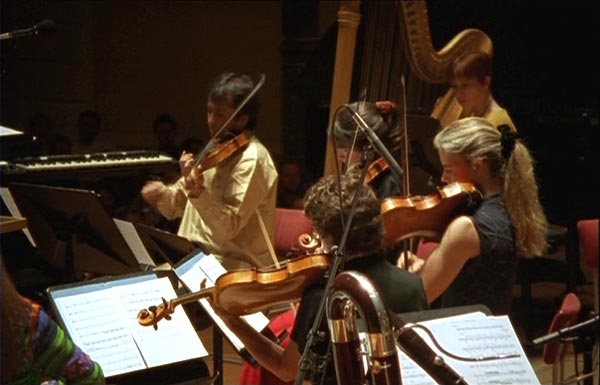ENSEMBLE MODERN CDs
The Ensemble Modern orginates from a student orchestra, calling themselves "Ensemble
modern der jungen Deutschen Philharmonie". They had as aim the performing and promoting of
contemporary music. In 1980 it was established as an independant entity, called The Ensemble
Modern. The ensemble has its base in Frankfurt, Germany, but its members are from divers countries.
It also tours worldwide. The group is made up of some 20 musicians, who govern themselves on
a democratic basis.
Their contacts with Zappa start in 1991, when they thought of performing a major orchestral
work of Zappa for the upcoming Frankfurt Festival. Zappa showed little enthusiasm for this idea,
but he was interested in having them perform new work. Three members flew to L.A. and soon
came to an agreement with Zappa. Then in July the whole ensemble came over to Zappa's studio
"Joe's garage" for the first round of rehearsals. In 1992 Zappa on his turn flew over to Frankfurt
for a second round. The result was a 90-minute program to be performed in three German cities.
The ensemble continues working as a protagonist of Zappa's modern music and recently brought out a second program on CD.
They rightfully claim to be Zappa's last band.
THE YELLOW SHARK, 1993.
The "Yellow shark" CD contains most of the material from these three concerts, all is recorded live.
It consists of modern compositions from Zappa's whole career. The oldest ones date from the late fifties and the sixties
and first appeared on "Uncle meat" (1969) in rock band versions. Then the "B-bop tango" from "Roxy and elsewhere" (1974) comes
along in a chamber orchestra version. But most material stems from the eighties.
One part is chamber music, mostly difficult outspoken atonal work. The other part is
synclavier music, that they were probing for the possibilty of human performance. The ensemble
got very far at this aspect. Three compositions were specifically made for the event. Below is the CD track list, the underscored ones can be opened
as midi file excerpts. These underscored tracks also all return in the study.
 1. Intro
1. Intro
2. Dog breath variations
3. Uncle meat
4. Outrage at Valdez
5. Times beach II
6. III Revised
7. The girl in the magnesium dress #1,
#2
8. Be-bop tango
9. Ruth is sleeping #1,
#2,
#3
10. None of the above
11. Pentagon afternoon
12. Questi cazzi di piccione
13. Times beach III
14. Food gathering in post-industrial America
15. Welcome to the United States
16. Pound for a brown
17. Exercise #4
18. Get whitey
19. G-spot tornedo #1,
#2
EVERYTHING IS HEALING NICELY, 1999
During the rehearsal sessions their was also room for improvisations and experimenting.
This was also part of the "Yellow shark" program, but not included in the corresponding CD.
From the live recorded improvisations Zappa did use some sections for inclusion in the "Civilization phaze III" CD.
In 1999 the Zappa Family Trust decided to release an entire CD mostly made up from the remaining studio tapes
of this kind. The majority of the tracks are
improvisations, directed by Zappa. Then there are some rehearsal recordings and the human execution of the synclavier
piece "Amnerika", that is taken from the three "Yellow shark" concerts. Impressive is the "T'Mershi Duween"
execution, that didn't become part of the "Yellow shark" program. In order to
enjoy this CD you have to take into
account that none of these experimental tracks were meant for official release, otherwise you might frown
upon a piece as mellow as "Nap time".
Since most pieces on this CD are unknown I try to give short descriptions of them.
Because it can only be ordered via the Zappa Family Trust its availability is also less. "Library card", "Master Ringo"
and "Wonderful tattoo!" are collages of spoken texts and improvisation by the ensemble. They take up
over 20 minutes of the 70 minutes CD. Ultimately
Zappa scored out "Welcome to the United States", based upon this idea. "This is a test" is dealt
with in the study, the Counterpoint #2 section. For "Jolly good fellow" Zappa handed over a melody,
that is played in various set ups with improvisation along with it. "Roland's big event/Strat vindaloo"
and "Naked city" are soloist improvisations with the ensemble accompanying. Roland Diry plays clarinet,
Zappa and Shankar combine on guitar and violin in a soft relaxed way, Jürgen Ruck plays accoustic guitar.
"Nap time" is a slow and lasting improvisation with among others the alp horn and gongs, executed
when everybody felt sleepy. In "9/8 Objects" the drumset plays in 4/4
over which a written figures in 9/8 and 4/4 are played; Shankar plays violin along with it. The other four pieces are known from earlier releases.
 1. Library card
1. Library card
2. This is a test #1,
#2
3. Jolly good fellow
4. Roland's big event/Strat vindaloo
5. Master Ringo
6. T'Mershi Duween
7. Nap time
8. 9/8 Objects
9. Naked city
10. Whitey (prototype)
11. Amnerika goes home
12. None of the above (revised & previsited)
13. Wonderful tattoo!
GREGGERY PECCARY & OTHER PERSUASIONS, 2003
In 2000 the Ensemble Modern performed a second program with Zappa's music
in some European cities. Among others they took part in the Holland Festival at
Amsterdam, that had Zappa as central composer that year. Two pieces from "Civilization phaze
III" are included, brought to a performing version by Ali Askin and Todd Yvega.
Todd also tried to turn "Xmas values" and "Buffalo voice" into performable score,
but that didn't work out. Apparently both compositions weren't based upon note entry
and Todd wrote a program that would approximate the sound via regular notation,
but the result was too far behind the original. Of course you can score out anything so that
the sound is about identical, but then the score becomes unperformable (no meters,
weird rhythm notation). "What will Rumi do?" is the only unreleased composition on the CD.
It's a 4/4 figure build up in layers, that ultimately got integrated in
"T'Mershi Duween" to see how the ensemble would play irregular groupings over it. This version
is included in "Everyhing is healing nicely". The largest piece on the CD is "The adventures of Greggery Peccary".
It has a hidden extra track in it. It namely doesn't stop at 21:17 but pauses several seconds and at 21:45
"Does this kind of life look interesting to you?" from "200 Motels" starts.
 1. Moggio
1. Moggio
2. What will Rumi do?
3. Night school #1,
#2
4. Revised music for low budget orchestra #1,
#2
5. The beltway bandits
6. A pig with wings #1,
#2
7. Put a motor in yourself #1,
#2, #3
8. Peaches en regalia #1,
#2
9. Naval aviation in art?
10. The adventures of Greggery Peccary #1,
#2,
#3
plus Does this kind of life look interesting to you?
CD covers: Zappa Family Trust and BMG records.
EIHN painting by Christopher Mark Brennan.
Greggery Peccary CD cover by Corbis and Hulton Getty Images.

The Ensemble Modern plays Zappa (photo by Allegri film/VPRO)
According to an Ali Askin interview (who was hired by Zappa
as an arranger for the Yellow shark project and others) by Thomas Fichter, the origins of this last CD lead back to 1996. After the 1996 US tour
by the Ensemble Modern, that included Yellow shark pieces, three of it's member visited Gail Zappa, who informed them about the
existance of the Greggery Peccary scores. It was in a closet of which she had lost the key. So this closet was broken up and
the unpublished scores came into light. It wasn't completely identical to the Studio Tan version. According to Ali Askin their were parts
on the album without underlying scores as well as written out parts that never reached the album. Ali arranged this piece
as well as synclavier music for the new release. For further information, visit www.ensemble-modern.com.
